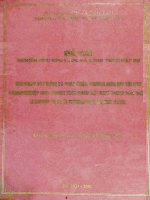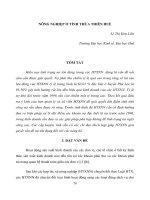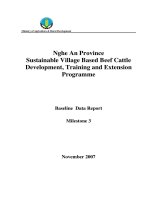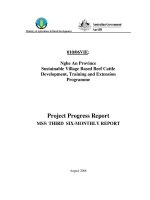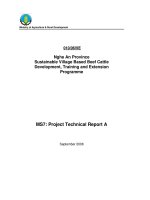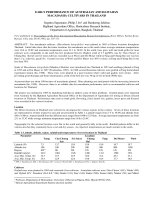Nghiên cứu khoa học nông nghiệp " Nghe An Province Sustainable Village Based Beef Cattle Development, Training and Extension Programme - Milestone 3 " pot
Bạn đang xem bản rút gọn của tài liệu. Xem và tải ngay bản đầy đủ của tài liệu tại đây (2.09 MB, 53 trang )
Ministry of Agriculture & Rural Development
Nghe An Province
Sustainable Village Based Beef Cattle
Development, Training and Extension
Programme
Baseline Data Report
Milestone 3
November 2007
Table of Contents
Part 1 - Background 1
Part 2 - Project Intervention Report 14
Part 3 - Training Needs Analysis: 19
Part 4 - Situation Analysis for Cattle in Nghia Dan District: 22
Part 5 Feed Conservation 28
Part 6 - Pastures and Feed: Situation Analysis and Options 32
Baseline Data Report
Part 1 - Background
Introduction
Nghia Dan District
Mr Long – Vice Chairman of the Districts Peoples Committee
Mr Hai – Director of Agriculture
Mr Hong – Vice Director of Agriculture and Forestry Department
Mr Toa – Director of the District Extension Office
Mr Lie – Senior Extension Officer
Nghia Dan District located in the north of the Nghe An Province in a hilly area. It has 75,000
of fertile land. The main production is Sugar cane, rubber, coffee, oranges, water melon and
cattle. It has: - 30,000 Buffalo
29,000 Beef Cattle
11,000 Goat
54,000 Pigs
The district is one of the most fertile in the province with good basalt soils with ph ranging
from 5.8 to 6.6. The potential for development of beef farming is very good. The district has
had in place a cattle breeding strategy for the last 4 years with the introduction of Sindhi cattle
via AI and natural mating. Most villages have a f2 – f3 Sindhi bull.
Main crops: - sugar cane, rice, oranges, water melon, corn, cassava, pineapple and peanut.
In the area there are processing plants for: - Sugar cane, Pineapple, Cassava
Village 1 = Nghia Son
Mr Tu General Secretary (also Chairman of People’s Congress)
Location in Nghe An District 1km from 19 May co
Population 3000
No. Families 800 (80% agricultural worker)
Families with beef cattle 160 families have beef cattle (total 400) 600 buffalo
Average No. of cattle 2.5 (lto 20)
Village Divided into five sections (sub-villages)
Technicians 1 x Agricultural and 1 x Animal for village – all men
Technicians 1 x Farmer for each section – all men
University Students 20 students studying at university
Average price of cattle At sale – 2,000,000 VND
Associations Farmer Association in place but no Farmer Cooperatives
Poverty Line 5% of families are below the provinces official poverty line
Village 2 = Nghia Lam
Mr Nhan General Secretary (also Chairman of People’s Congress)
Mr Sinh Chairman of Village People’s Committee
Location in Nghe An District 2km from 19 May co
Population 8000
No. Families 1400 (80% agricultural worker)
Land Area 3100 ha
Families with beef cattle 350 families have beef cattle (total 700) 1300 buffalo
Average No of cattle 2.5 (lto 20)
Village Divided into seventeen sections (sub-villages)
Technicians 1 x Agricultural and 1 x Animal for village – all men
Technicians 1 x Farmer for each section – all men
Average price of cattle At sale – 2,000,000 VND
Associations Farmer Association in place in each section but no Farmer
Cooperatives
Poverty Line 25% of families are below the provinces official poverty line
2
Village 3 - Nghia Yen
Mr Phu (Phan van) General Secretary (also Chairman of People’s Congress)
Mr Phue (Hoang van) Chairman of Village People’s Committee
Md Chu Chairperson of Woman’s Federation
Location in Nghe An District 5km from 19 May co
Population 6000
No. Families 1200 (85% agricultural worker)
Land Area 3447ha
Families with beef cattle 350 families have beef cattle (total 780) 1600 buffalo, 1800
goats, 3500 pigs
Average No. of cattle 2.0 (l to 53)
Village Divided into fourteen sections (sub-villages)
Technicians 1 x Agricultural and 1 x Animal for village
Technicians 0 x Farmer for each section, only starting training in livestock
Average price of cattle At sale – 2,000,000 VND
Associations Farmer Association in place in each section but no Farmer
Cooperatives
Poverty Line 53% of families are below the provinces official poverty line,
this is the poorest village in the area.
3
Summary of Base Line data
Introduction
Twenty-three smallholder farmers were interviewed over a one week period from 1st March
2007. The farmers selected all had beef cattle as a production system. This selection was not
totally random as we tried to get a cross section of smallholders.
Three different villages were selected in a 12Km radius of the 19 May Co. The villages were
approximately 25Km from Nghia Dan townships, and therefore were classified as rural
villages.
The three villages were very different ranging from 5% under the district poverty line to 52%.
All villages had a high percentage of ethic minority people.
Base Data
Family size and number of children were very similar, however land area owned varied,
ranging from 2000 m
2
to 80,000 m
2
(see Figure 1).
Nghia Yen smallholders had the largest land areas, but were the poorest of the smallholders.
Large areas of the Nghia Yen village were hillside and planted in rubber trees.
Nghia San village was the wealthiest village with high cash crop income. Most of the
smallholders had changed from taking their cattle out to graze on the common grazing land to
a cut and carry system reducing labour, but increasing feed costs.
House type, age of house was similar for Nghia Son and Nghia Yen, however, Hghia Lam
had more modern houses and with average age of 12.1 years vs approximately 20 years for
the other two villages.
Electric water pumps, refrigerators, freezers and phones were also a good indicator of wealth
and development (see Figure 2).
Land use differed greatly between the three villages. Nghia San had very little land for rice,
most of the cash crops were fruit trees, with very little land set aside for Elephant Grass.
Nghia Lam had good areas of rice land, large areas of sugar cane, water melons and most
farmers had an area of Elephant Grass for feeding cattle.
Nghia Yen had good areas of rice and larger areas of land for cash crops (sugar cane, cassava,
rubber, coffee). It was the only village with large areas of timber trees (see Figure 3).
Although the smallholders selected were all beef producers, the area of land dedicated to
growing crop and pasture for cattle was very low (3.3% on average). This represented 132 m
2
by cattle owned (7 per family). This highlights the reliance that the farmers place on crop
residue, bi-products and grazing common grazing land.
If beef production is to increase there will need to be a small increase in dedicated land for
growing cattle feed. However, crop residue and bi-products will still form the majority of
4
5
cattle feed. Therefore the project will focus on conservation of this type of feed and
improvements in the feed quality .
The average number of cattle per smallholder for the twenty-three farmers interviewed was 7
cattle. When asked what the restrictions to growing the cattle enterprise were, the orders of
responses were: -
• Lack of food over the Dry Season
• Lack of labour to graze with cut cattle feed.
• Lack of investment money to buy more cattle.
• High risk with Foot and Mouth and price fluctuations been experienced over the last few
years.
FIGURE 1
Base Line Data Family name No Family No Children Land Area Grazing Cattle Recommendation
Project 10/06 vn Ho va ten Tong so nguio So con trong gia dinh Tong dien tich dat Ti le chant ha Tong so bo Danh gia
1
Nghia Son
NGUYEN VAN
THO
5 1 15000 80% 6 ? Medium recommendations
2
Nghia Son
NGUYEN THIEN
TUNG
4 2 8600 80% 3 X Not recommended
3
Nghia Son
NGUYEN VAN
CAP
5 3 5700 80% 7 Y Strong recommendation
4 Nghia Son LE VAN HANG 5 2 5000 80% 3 X Not recommended
5
Nghia Son
NGUYEN THI
HUONG
4 2 1800 30% 5 Y Strong recommendation
6 Nghia Son DOAN THI HIEN 6 3 10000 70% 5 Y Strong recommendation
7
Nghia Son
NGUYEN SINH
TRUNG
5 3 2000 70% 6 N Not recommended
Nghia Son 4.9 2.3 6871 5.0
8 Nghia Lam
NGUYEN HUY
THE
3 1 2000 0% 2 N Not recommended
9 Nghia Lam DINH BA KIP 4 2 6120 50% 4 Y Strong recommendation
10 Nghia Lam PHAN DINH KY 5 3 30000 30% 5 Y Strong recommendation
11 Nghia Lam PHAN DUC HAI 4 2 30000 80% 7 ? Medium recommendation
12 Nghia Lam PHAN VAN BAY 5 4 20000 30% 9 N Not recommended
13
Nghia Lam
DUONG VAN
TINH
7 3 25000 30% 8 ? Medium recommendation
14
Nghia Lam
PHAN DINH
DUNG
5 3 20000 15% 3 ? Medium recommendation
15 Nghia Lam TRINH HAI LY 5 3 20000 30% 2 Y Strong recommendation
16 Nghia Lam
NGUYEN VAN
HIEN
5 3 30000 20% 6 N Not recommended
Nghia Yen Total 4.8 2.7 20347 5.1
17 Nghia Yen LE MINH LY 8 5 80000 80% 16 Y Strong recommendation
18 Nghia Yen LE VAN KIEM 4 4 20000 80% 15 ? Medium recommendation
19
Nghia Yen
DINH PHUOC
SON
6 2 80000 80% 8 N Not recommended
20 Nghia Yen BUI HUU SON 54 1 80000 50% 21 Y Strong recommendation
21 Nghia Yen HOANG CHI 4 1 60000 60% 3 N Not recommended
22
Nghia Yen
NGUYEN VAN
NHO
4 2 70000 80% 11 ? Medium recommendation
23
Nghia Yen
NGUYEN DUC
LUU
7 4 30000 30% 4 Y Strong recommendation
Nghia Yen Total 5.4 2.7 60000 11.1
5.0 2.6 29073 7.1
7
FIGURE 2
Base Line Data Family name
Total
Area
House
Wet
Land
(Rice)
Rubber Coffee Oranges
Lichie
Fruit
Other
Fruit
Trees
Sugar
Cane
Water
Melon
Cassava Corn
Other
Cash
Crops
Elephant
Grass
Other
Pasture
Trees
Project 10/06 vn Ho va ten
1 Nghia Son
NGUYEN VAN
THO
15000 500 7000 8000
2 Nghia Son
NGUYEN THIEN
TUNG
8600 1600 7000
3 Nghia Son
NGUYEN VAN
CAP
5700 1000 4000 500
4 Nghia Son LE VAN HANG 5000 2500 2500
5
Nghia Son
NGUYEN THI
HUONG
1800 400 500 500 500
6 Nghia Son DOAN THI HIEN 10000 1000 5000 4000
7
Nghia Son
NGUYEN SINH
TRUNG
2000 1000 1000
Nghia
Son
Total 48100 4500 7000 0 0 130000 0 15000 4000 0 0 0 4000 1000 0 0
8
Nghia Lam
NGUYEN HUY
THE
2000 200 1800
9 Nghia Lam DINH BA KIP 5120 200 3000 2000 1000
10 Nghia Lam PHAN DINH KY 30000 200 1600 28000 500 1000
11 Nghia Lam PHAN DUC HAI 30000 200 2500 25000 500 4000
12 Nghia Lam PHAN VAN BAY 20000 200 500 3500 16000 500
13
Nghia Lam
DUONG VAN
TINH
25000 200 500 20000 5000 1000
14
Nghia Lam
PHAN DINH
DUNG
20000 250 2000 15000 5000 1000
15 Nghia Lam TRINH HAI LY 20000 100 1000 18500 500
16
Nghia Lam
NGUYEN VAN
HIEN
30000 100 2000 3000 18000 1000 1000
Nghia
Yen
Total 183120 1650 10100 0 0 3000 3000 0 109500 27000 0 2500 20300 6500 0 4000
17 Nghia Yen LE MINH LY 80000 100 15000 14000 1500 50000
18 Nghia Yen LE VAN KIEM 20000 100 1500 3000 10000 7000
19 Nghia Yen
DINH PHUOC
SON
80000 100 1500 10000 2000 10000 3000 50000
20 Nghia Yen BUI HUU SON 80000 400 1500 10000 30000 4000 40000
21 Nghia Yen HOANG CHI 60000 400 2500 5000 20000 14000 1500 20000
22
Nghia Yen
NGUYEN VAN
NHO
70000 1000 5000 5500 20000 3000 35000
23
Nghia Yen
NGUYEN DUC
LUU
30000 400 3000 1500 8500 3500 3500 1000 12000
Nghia Yen Total 420000 2500 15000 10000 5000 17000 7000 0 50000 27000 52500 13500 3500 14000 0 214000
651220 8650 32100 10000 5000 33000 10000 15000 163500 54000 52500 16000 27800 21500 0 218000
8
FIGURE 3
Base Line Data Family name Chickens Goats Pigs Buffalo
Cattle F –
12m
Cattle M –
12m
Cattle F –
12m-2yrs
Cattle M –
12m – 2 yrs
Cattle F +2yrs Total Cattl
e
Project 10/06 vn Ho va ten
1 Nghia Son NGUYEN VAN THO 3 3 6
2 Nghia Son NGUYEN THIEN TUNG 6 1 1 1 3
3 Nghia Son NGUYEN VAN CAP 3 1 1 2 3 7
4 Nghia Son LE VAN HANG 2 1 2 5
5 Nghia Son NGUYEN THI HUONG 2 1 2 5
6 Nghia Son DOAN THI HIEN 2 1 2 5
7 Nghia Son NGUYEN SINH TRUNG 5 2 4 6
Nghia Son Total 14 0 0 0 4 7 6 0 14 31
8 Nghia Lam NGUYEN HUY THE 10 2 1 1 2
9 Nghia Lam DINH BA KIP 10 1 1 2 4
10 Nghia Lam PHAN DINH KY 40 2 1 4 5
11 Nghia Lam PHAN DUC HAI 25 2 3 1 3 7
12 Nghia Lam PHAN VAN BAY 50 2 4 5 9
13 Nghia Lam DUONG VAN TINH 2 3 5 8
14 Nghia Lam PHAN DINH DUNG 3 1 2 3
15 Nghia Lam TRINH HAI LY 50 1 1 2
16 Nghia Lam NGUYEN VAN HIEN 50 6 1 1 1 1 3 6
Nghia Yen Total 235 0 6 14 15 1 4 0 26 46
17 Nghia Yen LE MINH LY 100 1 2 13 16
18 Nghia Yen LE VAN KIEM 15 28 2 1 15 16
19 Nghia Yen DINH PHUOC SON 1 7 8
20 Nghia Yen BUI HUU SON 50 3 9 10 22
21 Nghia Yen HOANG CHI 50 10 4 1 2 3
22 Nghia Yen NGUYEN VAN NHO 20 20 1 5 6 11
23 Nghia Yen NGUYEN DUC LUU 30 5 2 4 4
Nghia Yen Total 265 28 35 9 9 3 11 0 57 80
514 28 41 23 28 11 21 0 97 157
6.8
9
FIGURE 4
Base Line Data Family name
House
Type
No of
Rooms
Age of
House
Water
Supply
Pump Kitchen Cooking
Phone /
Cell
Fridge Freezer TV/V/C Cart
Tractor/
Truck
Motorbike Electricity
Toilet
Outside
Project 10/06 vn Ho va ten
1 Nghia Son NGUYEN VAN THO T1 5 25 W N O WG YP N N TV/V N N Y1 Y O
2
Nghia Son
NGUYEN THIEN
TUNG
T1 3 25 W N O WE N N N TV/V N N Y1 Y O
3 Nghia Son NGUYEN VAN CAP T1 1 25 W N O WG N N N TV/V N N Y1 Y O
4 Nghia Son LE VAN HANG T1 1 20 W N O WG YC N N TV/V N N Y1 Y O
5 Nghia Son
NGUYEN THI
HUONG
T1 1 20 W N O WG YC Y Y TV/V N N Y1 Y O
6 Nghia Son DOAN THI HIEN T1 3 20 W Y O W N N N TV/V N N Y1 Y O
7
Nghia Son
NGUYEN SINH
TRUNG
T1 3 20 W Y O W N N N TV/V N N N Y O
Nghia Son 7 2.4 22.1 100% 29% 100% 70% 29% 14% 14% 100% 0% 0% 14% 100% 0%
8 Nghia Lam NGUYEN HUY THE T2 3 7 W N O W N N N TV/V Y N Y1 Y O
9 Nghia Lam DINH BA KIP T2 3 17 W Y B WGE YP N N TV/V Y N Y1 Y O
10 Nghia Lam PHAN DINH KY M4 3 4 W Y B WGE YP Y Y TV/V Y N Y1 Y O
11 Nghia Lam PHAN DUC HAI T2 3 16 W Y B WGE YPC Y Y TV/V Y N Y1 Y O
12 Nghia Lam PHAN VAN BAY M4 3 3 W Y B WGE YPC N N TV/V Y N Y1 Y O
13 Nghia Lam DUONG VAN TINH T1 2 30 W Y B WGE YP N N TV/V N YTK Y1 Y O
14 Nghia Lam PHAN DINH DUNG T2 3 20 W Y B W YP N N TV/V Y N Y1 Y O
15 Nghia Lam TRINH HAI LY T4 2 2 W Y I W YC N N TV/V N N Y1 Y O
16 Nghia Lam NGUYEN VAN HIEN T3 2 10 W Y O W YPC Y Y TV/V Y N Y1 Y O
Nghia Yen Total 9 2.7 12.1 100% 89% 22% 55% 89% 33% 33% 100% 78% 11% 100% 100% 0%
17 Nghia Yen LE MINH LY SOLD N/A N/A N/A N/A N/A N/A N N/A N/A N/A N N Y1 Y O
18 Nghia Yen LE VAN KIEM T3 2 4 W N O W YPC N N TV/V N N Y1 Y O
19 Nghia Yen DINH PHUOC SON T1 4 30 W Y O W N N N TV/V N N Y1 Y O
20 Nghia Yen BUI HUU SON T1 2 20 W Y O WG YC N Y TV/V N N Y1 Y O
21 Nghia Yen HOANG CHI T1 2 22 W Y O W YC N N TV/V N N Y1 Y O
22 Nghia Yen NGUYEN VAN NHO T1 2 20 W Y I W YC N N TV/V N N Y1 Y O
23 Nghia Yen NGUYEN DUC LUU T2 2 20 W Y I WG YPC Y N TV/V/C N N Y1 Y O
Nghia Yen Total 7.0 2.3 19.3 100% 100% 33% 33% 66% 16% 16% 100% 0% 0% 100% 100% 100%
17.26 100%
64% 41% 55% 70% 23% 23% 100% 30% 4% 100% 100% 0%
10
Key Farmers
On the second visit 9 Key Farmers (See below) were selected based on recommendation of the team and village leaders. The main selection criteria
were there ability to influence other farmers; had the financial base to be involved in the project and attend training courses.
Family Name No Family
No
Children
Land Area Grazing Cattle Recommendation
Ho va ten
tong so
nguoi
so con trong
gia dinh
tong dien tich
dat
ti le chan
tha
tong so
bo
danh gia
3
Nghia
Son
NGUYEN VAN CAP 5 3 5700 80% 7
Y
Strong Recommendation
4
Nghia
Son
LE VAN HANG 5 2 5000 80% 3
X
Not recommended
24
Nghia
Son
Pham Van Luong 4 2 4000 30% 4
Y
New
Nghia
Son
4.7 2.3 4900 4.7
10
Nghia
Lam
Chu Dinh Van 5 3 30000 30% 6
Y
Strong Recommendation
15
Nghia
Lam
TRINH HAI LY 5 3 20000 30% 1
Y
Strong Recommendation
25
Nghia
Lam
Phan Dinh Nhuan 5 3 40000 80% 10
N
New
Nghia
Yen
Total 5.0 3.0 30000 5.7
20
Nghia
Yen
BUI HUU SON 5 1 80000 50% 7
Y
Strong Recommendation
23
Nghia
Yen
NGUYEN DUC LUU 7 4 30000 30% 4
Y
Strong Recommendation
26
Nghia
Yen
Ngo Trong Tu
6 4 30000 80%
6
?
New
Nghia
Yen
Total
6.0 3.0 46667
5.7
5.2 2.8 27189 5.3
11
12
13
Part 2 - Project Intervention Report
The project team has identified a range of interventions that are targeted at improving
beef production of the project farmers and the Nghia Dan District.
The interventions are:
1. improve supply of quality food to beef cattle over the dry season through the
ensiling (fermentation) of a variety of feeds with additives
i.e. Pasture
- elephant grass
- wild grass
- new pasture species
crop residue
- cassava leaf
- maize stover
- rice straw
- sugar can top
- calypo vine
crop bi-products
- pineapple pulp
- cassava pulp
2. introduction of new tropical pasture species to improve nutrient supply to
cattle especially in the dry season.
3. introduction of new tropical legume species to improve nutrient supply to
cattle.
4. introduction of inter-crop planting of legume cover crops into existing crops
i.e. orange trees.
5. introduction of new beef cattle genetic material that will suit the local
environment and increase productivity of the local breeds. Introduction of
these new breeds through AI and then use of crossbred animals in a village
bull system.
6. improve farm management and beef profitability through training in nutrient
balancing, feed budgeting and farm management.
7. introduction of pedigree recording and liveweight monitoring of beef cattle.
8. improve extension of technologies through capacity building of technicians
and farmers in modern extension methods and the development of farmer
(discussion groups) field schools.
9. improve marketing of beef cattle through the development of farmer
association cooperatives.
1. Ensiling:
All farmers have identified the lack of forage over the dry season (November –
March) as a major restraint to their beef farming enterprises. The main source of
14
forage over the winter has been dry maize stover, rice straw, sugar can top and a range
of concentrate feeds (home made). Over the wet season and early autumn there is a
wide range of product available that could be ensiled and maintained in a relatively
good nutrient state as cattle feed over the winter. The project started to introduce the
silage technology in March 2007 and the results to date have been very successful in
most cases.
The project team is excited about the potential for ensiling fodder especially the wide
range of crop residues that are available within the District. The most promising
opportunity for improving beef cattle nutrition is in using a combination of pasture
and crop residues in silage mixes. To date the team has introduced elephant grass
mixed with maize stover, (with additives); elephant grass mixed with cassava leaf
(with additives) and maize stover mixed with cassava leaf (with additives).
All of these products are readily available within the District and utilisation of these
products at present is relatively low. It is estimated that there is approximately XX
hectares available within the project villages. Each hectare has the ability of
producing approximately 10 tonne (wet matter) which is equivalent to 2.8
tonne/hectare of dry matter. Cassava leaf has high protein at approximately 22% CP,
however green cassava leaf has high level of cyanogens , which means it can not be
used without ensiling to reduce this toxicity.
The use of processed bi-product does have potential as a source of cattle feed,
however, there are major issues surrounding the use of these products by small
farmers at the present time. The supply of product i.e. cassava pulp is intermittent and
seasonal, making it difficult for farmers that are not close to the processing plant to
access product. The real potential for utilising these products is for a joint venture
between a large corporate company and the processing company. The project has
made silage from pineapple pulp mixed with maize stover; the process was relatively
successful, however, supply of product was difficult to arrange and had started to
deteriorate prior to ensiling. Again the potential for large scale ensiling of this
product is outside the scope of most small farmers.
The estimated long-term potential is very good; there is approximately 1,000 hectares
of cassava grown, also 1,000 hectares of maize grown in the 3-project villages. This
provides the opportunity for approximately 5,000 tonne of DM to be available to
provide cattle fodder over the dry season (i.e. 150 days). This has the potential to
provide dry season food for approximately 8,000 cattle. This is a 250% increase on
the present 3,000 cattle that are in the project villages.
For more detailed information on progress to date see report on nutrient balancing
and ensiling.
2. Tropical Pasture Species:
The forages used in Nghe An are generally only an average or below average sources
of energy and are low in protein. Elephant grass is grown by many families but cut to
maximize bulk instead of quality. Wild grasses, sugar cane tops and dried corn stalks
are other major feed sources. There is a large surplus of feed during the summer wet
period, while feed is short for the late summer and cool season.
To improve beef cattle performance higher quality diets will need to be provided. The
pasture and feed consultants on this visit had a focus on pasture species options. There
are opportunities to improve cattle diets by both introducing new pasture species with
15
a proven performance in north east Thailand to sow new areas and in time replace
elephant (Napier) grass used by many farmers.
A number of species of pasture plants have been identified that have potential to
improve the nutrient value of pastures available to beef cattle. The two main species
identified are Mulatto II and Ubon Paspalum. Both these tropical grasses originated
from Brazil but have been introduced by Dr Michael Hare, Ubon Ratchathani
University, Thailand (project tropical pasture specialist). Both these pasture species
have the potential to produce between 20,000 – 30,000kg of DM/ha/yr. This is a
lower bulk than elephant grass but due to very high leaf to stem ratio and protein
levels, it provides higher levels of ME/ha/yr.
3. Tropical Legume Species:
Protein shortages may be alleviated by the increased use of forage legumes as either
long-term or as annual crop; or forage shrubs as a protein source. Due to the lower
production of legumes; there is some resistance from farmers to the large scale use of
many of the tropical varieties of legumes. The project has identified Ubon Stylo as
the best tropical legume for this area. It has the potential to provide a specialised high
protein product for young calves and lactating cows.
Hamata Stylo is a leafy annual legume, which has potential to be sown on common
grazing land and waste areas. This legume is self seeding and has the potential to
increase total feed supply on a village wide basis for the common good.
4. Crop Inter-Planting:
There are opportunities to inter-plant tree crops, especially acacia as well as wide-row
rubber and oranges plantations with legume or other forage crops. Land shortages
means that legumes have limited application except where they provide a direct
benefit to other cropping systems. Inter-cropping options needs to enhance the soil
and assist with weed control. Legumes provide the best option for inter-planting due
to their nitrogen fixing capability. At present calypo (traditional legume vine) is
being grown between a small area of orange trees as a ground cover crop. This
legume is a strong growing vine that provides good ground cover but due to relatively
high fibre and taste it is not readily eaten by cattle. However, it does have the
potential to be made into silage, especially if combined with green maize stover or
elephant grass.
There are a range of other legumes that maybe well suited to this role and the project
team has identified stylo, as well as cow peas as potential inter-planting varieties to
trial.
5. New Genetic Material:
There are approximately 29,000 cattle in the Nghia Dan District with the majority of
these being beef animals. Approximately two thirds are traditional local cattle and
approximately one third is Sindhi (Indian) cross local.
The local breed is small with low milk production. The Sindhi cross local in larger
but has a poor meat to bone ratio and meat percentage of 42%.
16
The majority of farmers still rear cattle under the traditional system. Under this
system manure production is the main priority transferring crop residue into organic
fertiliser. Bedding and food is supplied in such a way as to ensure a damp
environment to assist with the breakdown of fibre and the adding of animal manure to
increase its usefulness as a crop fertiliser. The traditional rearing system involved
6-8 hour grazing of cattle on the hills surrounding the village (common grazing land)
and the cutting and carrying wild grass back to the house to feed with dry yellow stem
corn (maize stover).
The level of nutrition is directly related to the season and the number of cattle reared
is governed by the feed supply over the dry season in October-March feed for 4-5
months of the year. The number of cattle is also governed by the labour available to
cut and carry the wild grass. Feeding levels of cows are very low due to the very
small size and low maintenance requirement.
Most cattle become an-oestrus over the winter dry season and do not start cycling
until April or May and calf in January-February the following year. Individual
farmers do not keep a male animal and use the village bull or a friend’s bull.
The focus for cattle breeding over the last 5-years has been the introduction of the
(Sinh) Sindhi breed to increase the size and milk production of the local cattle. The
strategy was based on the hope that a dairy production industry could be established
in the area, using ½ Holstein/Local cross (Sindhi) cattle, rather than development of a
cattle breed for beef production.
The Sindhi cattle programme has been successful and the (Sinh x local) cattle can
form a very good base for a beef industry. The Sindhi x local cattle have improved
milk production, size, good heat tolerance, disease resistance and easy calving.
However, the Sindhi cattle have a poor meat to bone ratio and a poor killing out
percentage.
The project team has spent quite a lot of time looking at a range of options for the
introduction of new genetic material. With a range of in-country advisors a SWOT
analysis was undertaken and a set of breeding objectives. The set of breeding
objectives indicated that the semen should be sourced from within Vietnam if at all
possible (to ensure price stability). The three options are available that meet the
criteria set. These are Brahman, Draughtmaster and Red Angus. The first choice for
the project would be Red Angus, however, semen for these will not be available until
2008, and therefore the project will start by introducing Brahman and Draughtmaster
in 2007.
These breeds will be introduced through frozen semen and AI technology; however,
as soon as ¾ bred bulls are available a village bull system will be developed.
6. Nutrient Balancing:
There is little understanding of nutrient balancing and the need to improve protein
feeding levels over the dry period. The traditional use of dry rice and corn straw is
still seen as the low cost option for winter feeding. Changing this approach and the
introduction of a change in management style to the farmers will be essential to
improving the beef industry.
17
7. Pedigree and Performance Recording:
Farmers have kept very few records, or recorded performance of their cattle. Detailed
recording is optional for small farmers but will be essential for the project to monitor
change
8. Extension Services:
The Extension Service provided by the local District Office is effective; however, it is
very localised and is not reaching many of the local villages or rural areas.
Extension methods are sometimes out dated; and introducing training in new
extension methodology will be important.
9. Marketing:
At present there is little co-ordination or depth to the marketing of beef cattle in the
district. An evaluation of this situation will need to be developed to assist the present
Farmers Association to look at opportunities
18
Part 3 - Training Needs Analysis:
Introduction:
The farmers in Nghia Dan District have been raising cattle for many years and have a
strong background in traditional village based cattle production. Therefore they have
some understanding and basic management i.e. reproduction, grazing, nutrition and
housing.
The training needs for the project is to build on this skill base as well as undertake
training on the new interventions that the project introduces. The four key
interventions that the project will introduce are: (for detail see report)
1. new pasture species and pasture management
2. conservation of crops and bi-products for dry season feeding
3. introduction of new breeds via AI
4. improve nutrient balance of feed.
The training programme will also focus on capacity building of local farmers,
technicians and leaders. High level training will focus on the 9 key farmers and the
ToT technicians within the district. However general training and workshops will be
open to general farmers in the three project villages.
Training events will include:
1. hands on demonstration of new interventions on the 19
th
May Co land and at
each of the key farmers houses. These will/have covered the following:
a silage making from
- elephant grass
- maize stover
- green maize
- cassava leaves
- pineapple waste
b sowing pasture seeds direct in nursery’s for transplanting and
nursery management
- Mulato II
- Paspalum
c sowing pasture seed direct into land for long-term feed supply
d transplanting of pasture cuttings from nursery’s into paddocks
e pasture cutting and plant management of new species of pasture
f animal recording, ear tagging of animals, age estimation and
pedigree recording
g Oestrus detection of reproductive management
h in-cropping of legume into existing crops
19
2. Project based workshops at 19
th
May Co teaching room – subjects will
include:
a Nutrient balancing of feed
b Use of pasture as animal feed
c Silage making and fermentation process
d Cattle reproduction management
e Introduction of new breeds
f Inter-crop planting of legume into orange tree crops
g Pedigree recording and liveweights of cattle
h Pasture management
i Seed/seedling production and marketing of seed/seedlings to
other farmers
j Marketing of beef cattle and development of farmer cooperatives
k Development of farmer field schools and possible benefits
3. Special in-country training for farmers and technicians:
To build capacity and training farmers in new technologies is important to
expose them to other farmers who are already using new management
techniques. Also introduce them to in-country expertise. This will be done
through undertaking two in-country training programmes over the projects.
The first special in-country training will be a 3-day training programme held at
BFCRC in Bavi in October 2007 and run by the centres technical and
scientific staff. (see appendix A for full programme)
4. Special in-country skill based capacity building training for key technicians:
Train one technician in AI at BCFRC Bavi for 35 das and then provide one on
one supervision and training in the Nghia Dan area for 3-months.
Train on technician at 19
th
May Co in pedigree recording and data storage and
management using both manual and computer software.
5. Targeted out of country training – needs identified to date:
4-day training course at Thailand Ubon Ratchathani University on village
based pasture seed production. This training will expose 6 key farmers and 4
technicians to modern village based beef and dairy farming systems in a
tropical region in Thailand. This training and farmer visits will be undertaken
by Dr Michael Hare.
A 10-day visit to NZ for 2 people to expand their overall knowledge of beef
farming and farm management systems.
Two junior agricultural graduate students from Hanoi Agricultural University
to undertake 2-month training at Massey University.
Conclusion:
20
The above training needs analysis will deliver a broad based training programme
that should help to lock in the new technologies and technical skills in the district.
It will build capacity and expose a range of Nghia Dan District farmers and
technicians to new beef farming methods.
At present the training needs analysis has not focused on the radial extension of
the project outside the 3-project villages in the Nghe An Province. This is a
weakness in the training programme that will need to be addressed over the next
year.
The project is not funded to undertake an extended “Road Show” of seminars
around the Province, however, it will be important to at least run a seminar at
Nghia Dan District Extension Centre and run a full one day seminar at the project
site for all beef farmers and technicians in a 20-30km radius.
21
Part 4 - Situation Analysis for Cattle in Nghia Dan
District:
There are approximately 29,000 cattle in the Nghia Dan District with the majority of
these being beef animals. Approximately two thirds are traditional local cattle and
approximately one third is Sindhi (Indian) cross local.
The local breed is small with low milk production. The Sindhi cross local in larger
but has a poor meat to bone ratio and meat percentage of 42%.
Red Sindhi
Also Known By: -
Malir (Baluchistan), Red Karachi, Sindhi
The Red Sindhi originated in the Pakistani
state of Sind but due to its hardiness, heat
resistance and high milk yields they have
spread into many parts of India and at least
33 countries in Asia, Africa, Oceania and
the Americas.
Under good management conditions the
Red Sindhi averages over 1700 kg of milk
after suckling their calves but under
optimum conditions there have been milk yields of over 3400 kg per lactation.
The average height of a Red Sindhi cow is 116 cm with a body weight of 340 kg.
Bulls average 134 cm in height and a body weight of 420 kg. They are normally a
deep, rich red color but this can vary from a yellowish brown to dark brown. Males
are darker than females and when mature may be almost black on the extremities,
such as the head, feet and
tail.
Local Sindhi Cross
22
Under Local Nutritional Conditions
Breed Birth WT 12-month WT Mature Female Mature Male
Local 16-18 90-110 280-300 300-350
Local/cross
Sindhi
18-20 110-120 300-350 400-450
Local cross
Sindhi/ Holstein
20-22 120-150 320-400 400-500-
Traditional Cattle raising System:
The majority of farmers still rear cattle under the traditional system. Under this
system manure production is the main priority transferring crop residue into organic
fertiliser. Bedding and food is supplied in such a way as to ensure a damp
environment to assist with the breakdown of fibre and the adding of animal manure to
increase its usefulness as a crop fertiliser. The traditional rearing system involved
6-8 hour grazing of cattle on the hills surrounding the village (common grazing land)
and the cutting and carrying wild grass back to the house to feed with dry yellow stem
corn (maize stover).
The level of nutrition is direct related to the season and the number of cattle reared is
governed by the feed supply over the dry season in October-March feed for 4-5
months of the year. The number of cattle is also governed by the labour available to
cut and carry the wild grass. Feeding levels of cows are very low due to the very
small size and low maintenance requirement.
Most cattle become an-oestrus over the winter dry season and do not start cycling
until April or May and calf in January-February the following year.
Individual farmers do not keep a male animal and use the village bull or a friend’s
bull.
Change to the Beef System over the last 5 years:
The Nghia Dan Ministry of Agriculture has had a beef development project for the
last 5-6 years, which has started to change the traditional ways of rearing beef. The
Ministry of Agriculture introduced a cross breeding programme using AI and putting
F1, F2 bulls into villages as “village bulls”. This strategy has been very effective and
approximately 1/3 of cattle are now Sindhi cross and all “village bulls” are cross bred
(F2 – F3).
In the 3 project villages approximately 50% of farmers have used AI and sometimes
natural mating. The level of conception rate report ranged from 30% - 100%; the
average being 40-55%. This is a very high rate for village based AI with considerable
time and effort was taken to verify this figure. The true conception rate is likely to be
in the 40-50% range and reflect well on the local animal extension officer (Mr Li).
About 1/3 of farmers have moved to a cut and carry system. Sugar cane top is a large
source of food from November – April. Wild grass is plentiful during May, June &
July. Maize stover (yellow stem corn) is the main source of fibre, 2-3 crops of maize
23
can be harvested each year. 10% of farmers interviewed reported using green feed
maize (the smaller plants) as cattle feed.
The wealthier farmers are moving to cut and carry and are prepared to buy some cattle
food and bi-product. The poor farmers rely totally on self produced feed and grazing.
No farmers in this area have used silage or have made silage, however, some had
heard about silage and knew of people who had made silage.
Estimate of Feed Intake of Beef Cattle (kg DM/day)
Breed 12mth
Winter
12mth
Summer
Female 2-
yr Winter
Female 2-
yr
Summer
Local 1.5 2.2 4.5 6.4
Sindhi/cross
local
1.7 2.4 6.0 7.0
European Beef 3.8 4.8 7.0 12.0
There is a large variation in the condition of cattle of the 23 farmers interviewed.
Condition Score:
1.5 – 2 very thin 10%
2 – 3 thin 30%
3 – 4 medium 40%
4 – 5 good 20%
Considering that the visit and assessment was in March at the end of the Winter the
situation was not bad. The high area of sugar cane in this district is likely to have a
positive effect on the cattle.
Development of a new Cattle Breeding Strategy for the District:
The focus for cattle breeding over the last 5-years has been the introduction of the
(Sinh) Sindhi breed to increase the size and milk production of the local cattle. The
strategy was based on the hope that a dairy production industry could be established
in the area, using ½ Holstein/Local cross (Sindhi) cattle, rather than development of a
cattle breed for beef production.
The Sindhi cattle programme has been successful and the (Sinh x local) cattle can
form a very good base for a beef industry. The Sindhi x local cattle have improved
milk production, size, good heat tolerance, disease resistance and easy calving.
24
